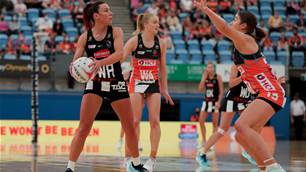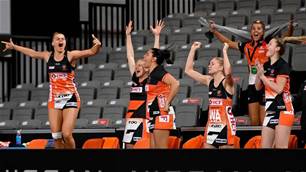To the uninitiated, piling on the points in netball can seem as easy as getting the ball down to a dead-eye Goal Attack or Goal Shooter and watching the scoreboard tick.
To the uninitiated, piling on the points in netball can seem as easy as getting the ball down to a dead-eye Goal Attack or Goal Shooter and watching the scoreboard tick. This is bloody harder than it looks, though, especially with defenders like Sonia Mkoloma lurking inside the circle.
 Sonia in training
Sonia in trainingImages: Getty Images
Mkoloma is the NSW Swifts’ import with 102 Test caps for England to her name. Australian and New Zealand netball wins on all counts having the former Central Pulse (2008) and Canterbury Tactix (’09) star plying her trade in the antipodes. Firstly, we get to see her silky skills up close in the trans-Tasman ANZ Championship week in, week out. Secondly, England officials have reversed their decision to judge their prospective overseas-based reps ineligible for the upcoming World Champs in Singapore in July ... Another win for fans of the international game as our nation eyes a three-Test home series against the Old Country in October.
If you have a netball-playing daughter (yes, yes, okay, or son) whose leaning towards spending her winter weekend mornings down the defensive end of the court, sit her in front of the TV for a Swifts game starring NSW’s 183cm London-born veteran.
Inside Sport caught Mkoloma one afternoon at a Swifts training session and asked her to take usto school on the finer points of netball defence.
PLAN OF ATTACK
“Each week the Swifts have two two-hour court sessions. These are made up of specific ball skills and unit work. Each courtwork session is broken up into smaller segments and then we join everything together. There’ll be full-team work, either as a full team in defence or a full team attacking the ball through the court. As I’m a defender, working on my combinations with my partners on the court is important.
“There’s two strength and conditioning sessions a week, too, which we actually do at the Sydney Swans’ gym. These sessions alter between strength components with weights, stamina, speed and conditioning.
“After that it depends on the individual. Some weeks you might feel like you could do with a little bit more work, so you might go to the gym and do a bike session. Or, say if you don’t play one weekend or you don’t get much court time, then you’ll do a top-up session, which may consist of interval swimming, a bike ride, a session on a cross trainer or a run. The top-up sessions last for a max of 50 minutes; because the competition’s so tight, you don’t want to overdo it and become fatigued.”
GOING TO COURT
“Our courtwork sessions tend to start with a warm-up, just getting our hand, eye and feet coordination fine-tuned; basic ball work, reaction drills. Then we break up into our units. The defensive unit is made up of the Goal Keeper, Goal Defence and Wing Defence. We’ll do specific stuff in and around the goal circle. It could be working towards the next match, or focussing on what hasn’t been working for us as a unit. We focus on man-on-man marking, setting up zones ...
“When we break into units, we’ll run through stuff like routine ballwork, stuff which will get us reacting. Then we might focus on centre pass defence. We’ll talk about what we want to get out of each tactic we practice, then we’ll run through it four or five times and talk about it again afterwards; about how we may be able to improve it. Then we’ll go out and hit it again. It’s good, specific work.
“What we focus on changes depending on what the team needs to get out of it and who the opposition is, especially in a tournament like the ANZ Championship, where the games are week in, week out. Some teams we only play once, so we know we need to analyse them, play them and move on. You can’t dwell on what happens against these teams because you’re not going to hit them again.”
Related Articles

Round 2 Suncorp Super Netball Pic Special

'A dream come true': NSW Swifts 2020 Preview













